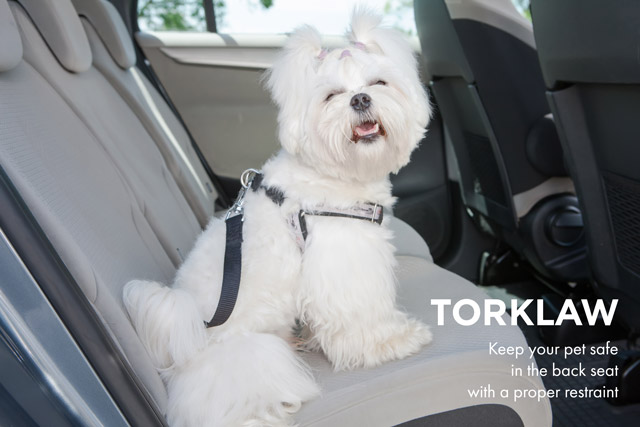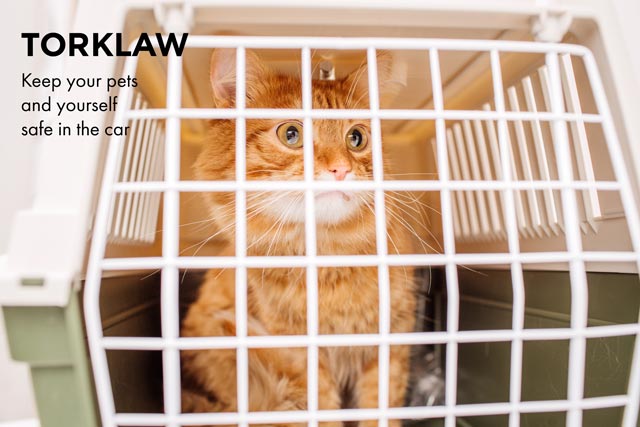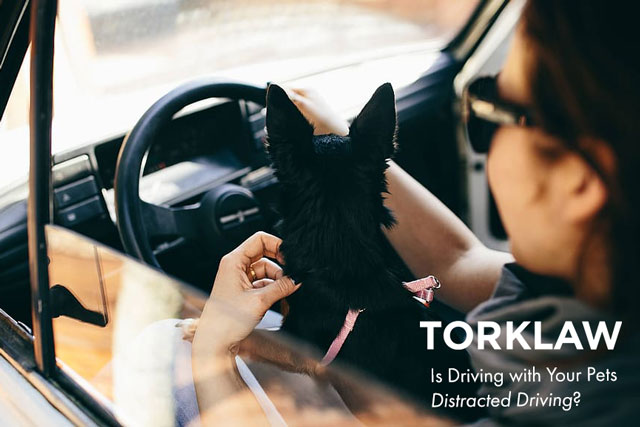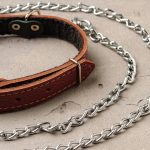On December 20, 2018, a new law went into effect in the Village of Mantua, Ohio banning drivers from holding or allowing an animal to sit in their lap while driving.
Does that seem harsh? Many pet owners love having their canine companions by their side as often as possible – after all, they’re great company. They’re always happy to be with us, they’re amazing listeners, and they never argue.
Nevertheless, while it may seem harmless to let our Lhasa Apso lap-sit, or our Rhodesian Ridgeback ride shotgun while we’re driving, it can be dangerous – for the dog, the driver, and the passengers. Does that mean you should never take your Jack Russell Terrier for a joyride? Not necessarily – keep reading for ways to keep your pet safe in the car.
Statistics
According to the National Highway Traffic Safety Administration (NHTSA), at any given moment in the United States, 2% of drivers are texting, and 4% are on handheld phones. Nine people die every day because of distracted driving.
A survey by the American Automobile Association (AAA) showed that over 80% of dog owners drive with their pets in the car – but only 16% use a pet travel restraint! Some reasons respondents gave for not using proper safety restraints were:
- Their dog is well-behaved and doesn’t need one
- They just never thought about it
- They only take their dog on short rides
- Their dog likes to hang its head out the window
- Too much trouble
- It’s no fun for the dog
- They want to be able to snuggle with the dog

Reasons Your Dog Shouldn’t Be on Your Lap (or Loose) When You’re Driving
If you’re one of those people who doesn’t restrain your dog in a moving vehicle, here are the top reasons you should purchase and use a proper auto restraint for your pet:
Your Pet Could Be Injured or Killed
Let’s say you have a Bichon Frise that weighs about ten pounds. She is in your lap while you are driving on a highway at about 50 mph. A car swerves into your lane and you crash into the highway barrier. Your unrestrained companion is slammed into the car window with approximately 500 pounds of force. Since it only takes about 100 pounds of force to break tempered glass, the window shatters and she is thrown onto the freeway.
For those who only take their dogs on short trips, never on the highway, consider this: if you are driving only 30 mph with your Doberman Pinscher in the car, and you have a collision, your 80-pound Dobie can go through your windshield with roughly 2400 pounds of force, no matter how well-trained that dog is.
Another potential injury: airbags. During a collision, airbags deploy at 200 mph. If your dog is in the front seat, even if he is restrained, he could still be injured or even killed by the force of the airbag.
If your dog is seriously injured in a car accident, resulting in expensive medical bills, the amount you can receive from an automobile insurance policy is very limited. You could sue the at-fault driver for your pet’s medical expenses, but if your pet was unrestrained, you may be found comparatively negligent, which would severely reduce your damages.
Your Pet Could Injure You or Your Passengers
The AAA survey revealed that 83% of respondents agree that driving with an unrestrained dog is unsafe. But 65% also admitted that they do engage in distracting activities when driving with dogs, such as:
- Petting or stroking the dog
- Holding the dog in place when stopping
- Struggling to keep the dog from climbing into the front seat
- Reaching into the backseat to play with/pet the dog
- Holding a small dog or letting the dog sit on their lap
- Giving treats to the dog
- Taking pictures of the dog!
A recent study showed that taking your attention off the road for even two seconds increases your chance of crashing up to 24 times. For example, police believe this fatal single-vehicle accident was caused by the Chihuahua on the driver’s lap. Sadly, both driver and pet died in the collision.
Then there are car accidents caused by pets, like this German Shepherd who caused a rollover by jumping on the dashboard to bark at the windshield wipers. Thankfully, everyone survived that incident with only minor injuries.
Examples in the previous section described what happens to unrestrained dogs in car accidents. Now, imagine there are passengers in those cars. Instead of the dog going through a window, the dog could slam into a passenger with 500 – 2500 pounds of force. This could injure or kill passengers who, if they were properly restrained with seat belts or child seats, would probably have survived the accident with minor injuries, if any.
And, you could be sued by your passengers for their injuries – or by their families in a wrongful death claim – for your negligence in leaving your dog unrestrained while in a moving vehicle.
It Might Be Against the Law
In Hawaii, driving with a dog in your lap is punishable by a $97 fine, and having an unrestrained dog anywhere in the vehicle is a $57 fine. In many other states, laws against distracted driving or transporting unrestrained animals mean you could be ticketed for driving with a dog in your lap. A ticket for distracted driving can cost you up to $500, depending on the state.
Many states also have laws against driving with anything that obstructs the driver’s view, which could also apply to driving with an animal. In North Dakota, a 76-year-old woman driving with her Shih Tzu drove into a pond when her newly adopted dog, who, she was told, was “real good in the car,” suddenly jumped into her lap. Luckily, the woman and the dog were fine.

Do’s and Don’ts of Driving with Your Pets
Of course, the best-case scenario is to properly restrain your pets while they’re in a moving car with you. Here are some rules to follow to make sure they’re safe:
Don’t:
- Drive with your pet in your lap.
- Allow the dog to ride in the front seat, unless your car has an automatic sensor or manual switch to override the airbag.
- Simply hook the dog’s leash to the car, or put her in an unsecured crate or carrier (that goes for cats, too). If you use a crate, secure it to the vehicle with seat belts or anchor straps.
- Let dogs ride in an open truck bed, whether leashed or not: they may fall, jump out, or be thrown out in a collision. If they are leashed, they could choke.
- Leave them in an unattended car for any amount of time, ever. Pets left in cars risk injury or death from heat stroke or dehydration as temperatures rise. If you’re not in the car, your pet shouldn’t be either.
Do:
- Purchase a restraint system (harness, carrier or crate) that is appropriate for your pet’s size – and use it! (These are independently-certified recommendations.)
- Secure them in the back seat, where they’re not only safer, they’re less distracting.
- Give your pets some food and water before you leave, and stop every two hours to give them water and a bio break.
- If going on a trip, make sure you have your pet’s medications, records and ID with you, just in case.
For many, pets are part of the family. If you wouldn’t let a small child ride in your car without a car seat, it follows that you should not allow your fur-baby to ride in your car without a harness or secured pet carrier. The TorkLaw team wants you and your pets to stay safe – always use the proper pet restraints when driving with pets in the car, and keep them secured in the back seat.
If you have been injured by a negligent driver, call the distracted driving accident attorneys at TorkLaw for a free, no-obligation consultation. Our experienced personal injury attorneys can help ensure you have everything you need to recover.
Did you find this post informative? You may also want to check out the below content:
Distracted Driving Awareness Month: Daydreaming Drivers





